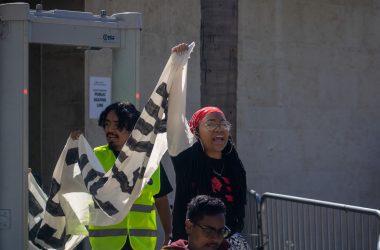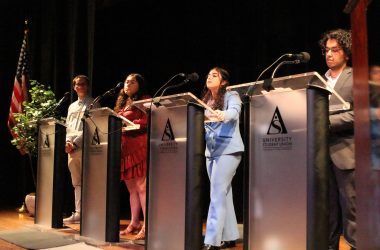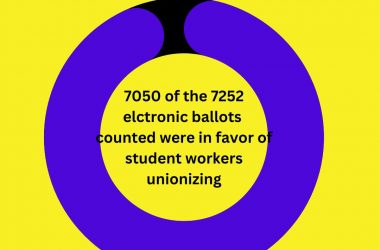California State University Chancellor Timothy P. White will hold an open forum today where students will be able to discuss innovation on campus that leads to student success.
White has been on a systemwide tour of all the California State Universities to connect with students, faculty and influential community members.
This is the ninth formal visit this year designed for White to get greater insight into the faculty-student interface of each campus. The idea is for White to immerse himself among students to see what works and what doesn’t work with “innovation in academics.”
The Daily 49er talked with the chancellor before the forum to discuss some of the biggest issues White faces, including the wage disagreement with the California Faculty Association, disparate graduation rates and student success.
What innovative student learning have you seen in the tours so far?
I’ve found it an informal learning environment, such as visiting with students in anthropology who are learning how to do digs out in a mock-dig site. And then finding out that the reason that that student is interested in [anthropology] is because she wanted to, when she graduates, give back to society by helping identify bones of veterans in horrific events that happen around the world, and she wants to reunite the family with the bones of a dead veteran. So what I learned there is how deep our moral fabric can go.
Those insights help me do my job as chancellor, representing you as a student and all the other students and our employees and what we do in the business sector and with our elected officials. These visits are not just interesting and engaging in and of themselves, they give me the hands-on feeling, the fingers on the pulse, if you will, of what’s working and what’s not working.
What have you seen on the campuses that works well?
I’ve seen how faculty have integrated technology into relatively large lectures, to help personalize the learning for individual students, and how it also gives the faculty member in real-time a sense of whether the important content of the day’s discussion is being received or not … For me, the use of technology is to really supplement the human factor of teaching and learning and enhance and embrace and facilitate it, but never to replace it.
What have you seen on the campuses that does not work well?
Some of [the problems] are when we don’t have enough courses at the right time, or students can’t get the information they need in academic advising, or [can’t] get into financial aid in time and run into financial problems that could’ve been avoided. So there’s operational and logistical things that don’t work.
What are some ways you think the CSU’s can improve that?
. . . Having the courage to say, ‘This is a really good idea, [a] practice that is creating more student achievement and more success, let’s try and scale it up, take it to more classes on a given campus or take it across many campuses.’ And sometimes we try things that end up not making an improvement, then we have to have the courage to say, ‘Well we gave this a solid chance, we looked at the outcomes and they’re not any better, so let’s stop doing this intervention and try some other one.’
In terms of faculty helping each other be successful, how do you feel about the current threat of a strike from the California Faculty Association? How do you think that is going to affect student success?
Clearly students have a right to have an expectation that their learning environment does not get disrupted. So if there were to be a disruption, that seems to me to be not fair to students, and I’m hopeful that we’re in active bargaining with union leadership, and that’s where those conversations, you know, libel, practice, policy and law have to be. But I’m optimistic that we will find solutions and that students will not be negatively impacted.
I’ve been reading that the CFA feels that a one day strike won’t hurt students. How do you feel about that?
Like I say, what I’d like to do is direct some of this energy that is being expressed now and have everybody come back together, as we have in the past and focus that energy on Sacramento in our advocacy activity.
So part of my role is, while I acknowledge the concerns that are out there, and I understand them, and I appreciate people’s passion about the CSU, I’m also a realist and practical about this and let’s turn that energy, that attention, to the halls of the capital and Sacramento, which is where a little bit of over half of our resources come from, and turn that energy into ways of serving California’s future by educating students, staying focused on students and student success.
In Governor Brown’s budget report this year, he said that only 15 percent of students are graduating in four years and criticized the CSU for trying to boost enrollment rates when they aren’t graduating students at the same rate. How do you respond to that?
Several years ago, we started what is called the Graduation Initiative, which was then a very focused effort on all 23 campuses as well as here in the chancellor’s office to improve the graduation rates of the [CSU] students. Now, graduation rates can be calculated a whole host of ways. The federal way, which is what the governor is referring to is on what’s called the [Integrated Postsecondary Data System], a national database graduation rate test calculated totally on students who are first time freshmen, going full-time.
As you well know, many CSU students don’t go full-time.
That’s different than the elite universities in America where kids typically come out of high school . . . and [when] they go to school, they’re fully prepared. They have no academic deficiencies because they’ve come out of amazing public or private schooling . . . and they can get in and out in four years.
But at the CSU, we have many students. They’re older than average, they’re working, they transferred in from community colleges, then they stop in and stop out on their way to a degree.
So that’s why the six year graduation rate, not only for CSU, but for almost any university in America, is a more realistic measure of success.
But what we really need to have in this country and this state is really keeping track of enrolled time to degree … We don’t measure enrolled time to degree, which would really be an accurate way, because the databases, when they got set up in the ‘50s and ‘60s, were set up for traditional college kids that go to school for four years and get out. There’s a lot of national effort and we’re part of that effort to try and redefine the way in which we measure graduation success — measure it in a way that’s appropriate to and realistic for today’s students, which are much more heterogeneous and varied than they were back in the ‘50s, ‘60s and ‘70s.
So I will never apologize for our students. We are focusing on improving the 4-year rate, we are focusing on improving the 6-year rate and the 8-year rate.
. . . Sometimes it takes a while to get there, and it’s really important . . . it’s not where you start, it’s where you end up, and it’s what you do along the way that really matters.




